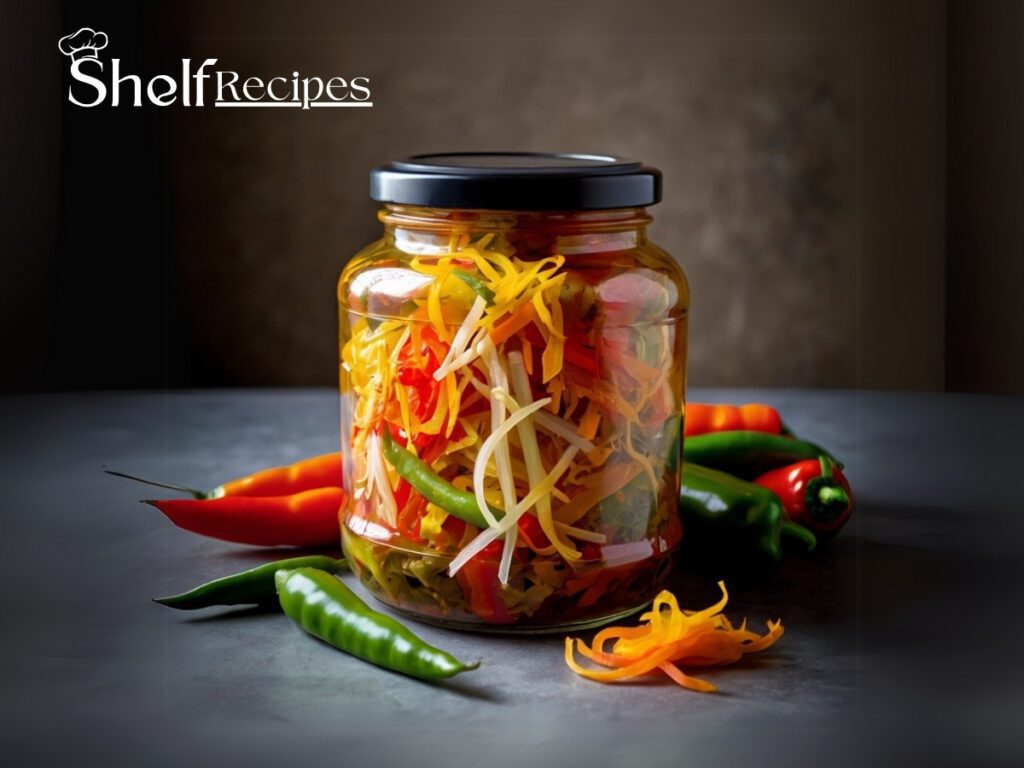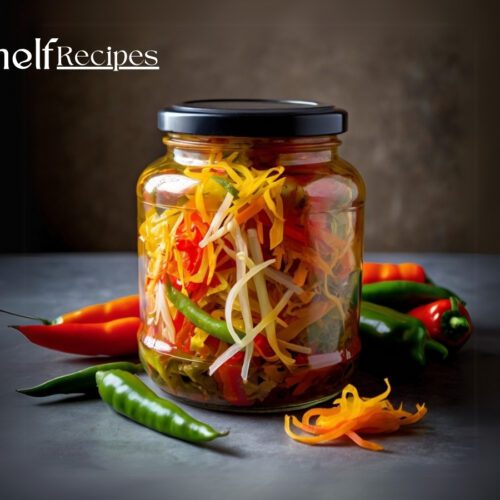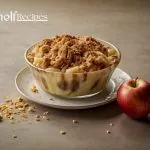
It is a vibrant, spicy Haitian condiment that brings bold flavors to any dish. Made with crisp vegetables and fiery scotch bonnet peppers, it’s a versatile addition that pairs perfectly with fried or grilled dishes. Whether discovering this delightful recipe for the first time or looking to perfect your homemade version, this guide has everything you need to know.
What is Pikliz?
(pronounced “pick-leez”) It is a traditional Haitian pickled vegetable relish made from shredded cabbage, carrots, bell peppers, and scotch bonnet peppers. It’s marinated in vinegar with a mix of spices, resulting in a tangy, spicy, and flavorful condiment. Known for its bold kick, pikliz adds a unique taste to meals and enhances the flavors of dishes like fried plantains, grilled chicken, and fish.
Why You’ll Love It
- Burst of Flavor: Its tangy and spicy notes make every bite exciting.
- Healthy and Fresh: Packed with raw vegetables and no preservatives.
- Easy to Prepare: Minimal cooking and simple ingredients.
- Long Shelf Life: Store it in the fridge, and it lasts for weeks.
The History and Cultural Significance
Pikliz is a staple in Haitian cuisine, deeply rooted in the country’s culture and traditions. This spicy pickled vegetable medley is often served alongside fried or grilled dishes to provide a tangy, fiery kick. Beyond its bold flavor, pikliz represents the resourcefulness and creativity of Haitian cooking. Its long shelf life and simple preparation make it an essential condiment in many households.
Ingredients
Before diving into the recipe, gather the freshest ingredients for the best results:
- Cabbage: The star ingredient, providing crunch and texture.
- Carrots: Add a hint of sweetness and vibrant color.
- Scotch Bonnet Peppers: Deliver the signature heat and spiciness.
- Onions: Offer sharpness and balance to the flavor profile.
- Garlic: Enhances the overall taste with its savory notes.
- Vinegar: Acts as the pickling agent, infusing the vegetables with tanginess.
- Optional Spices: Cloves, thyme, or peppercorns for added depth.
Essential Kitchen Tools
Having the right tools on hand makes preparation easier:
- Sharp Knife: For thinly sliced cabbage, carrots, and other vegetables.
- Mandoline Slicer: Ensures uniform cuts for an even texture.
- Mixing Bowl: A large bowl to combine and mix the vegetables thoroughly.
- Sterilized Jar with Lid: Essential for storing pikliz and maintaining their freshness.
- Cutting Board: Use a sturdy board, preferably one reserved for vegetables.
- Gloves: Protect your hands from the heat of the Scotch bonnet peppers.
Health Benefits
Pikliz isn’t just flavorful; it’s a healthy addition to any diet.
- Rich in Antioxidants: Vegetables like cabbage and carrots are packed with antioxidants that promote overall health.
- Boosts Digestion: The acidity from the vinegar can help improve digestion and balance gut health.
- Low-Calorie Option: Perfect for adding flavor without extra calories or fat.
How It Fits Into Modern Cuisine
While traditionally Haitian, pikliz has found its way into fusion dishes worldwide. Chefs use it to top burgers, tacos, and even pizza for a spicy crunch. Its adaptability makes it a popular choice for anyone looking to add bold flavors to their meals.

Pikliz
Ingredients
Vegetables:
- 1 small cabbage shredded
- 2 carrots julienned
- 1 bell pepper thinly sliced
- 1 medium onion thinly sliced
Spices:
- 3 scotch bonnet peppers sliced; adjust to taste
- 2 cloves garlic minced
- 2 teaspoons salt
- 1 teaspoon black pepper
Liquid:
- 1 cup white vinegar
Instructions
Prepare the Vegetables
- Shred the cabbage and julienne the carrots. Thinly slice the onion and bell pepper.
- Mix the vegetables in a large bowl.
Add Heat and Flavor
- Slice the scotch bonnet peppers and mix them into the vegetables. Be careful handling these peppers; wash your hands thoroughly afterward.
- Add minced garlic, salt, and black pepper.
Marinate
- Pour white vinegar over the vegetable mixture, ensuring all ingredients are fully submerged.
- Toss everything together and transfer to a sterilized jar.
Store and Wait
- Seal the jar and refrigerate for at least 24 hours to allow the flavors to develop. Pikliz tastes best after a few days of marination.
Tips for the Best Condiment
- Use Fresh Vegetables:
Freshness is key to achieving the crisp texture and vibrant flavor that defines great pikliz. Always choose firm, brightly colored vegetables. Avoid wilted or overly soft cabbage, carrots, or peppers, as they can affect the overall quality and crunch of the final product. Washing your vegetables thoroughly before preparation is also essential. - Control the Heat:
Scotch bonnet peppers are known for their intense heat and fruity undertones. If you prefer milder pikliz, remove the seeds and membranes from the peppers before adding them to the mixture. For those who enjoy a fiery kick, include the seeds and consider adding an extra pepper. Be cautious while handling scotch bonnets—wear gloves if necessary, and avoid touching your face. - Sterilize Your Jar:
Sterilizing your jar is crucial for extending the shelf life of your pikliz. Use a heatproof glass jar, wash it with hot soapy water, and sterilize it by boiling it in water for 10 minutes. Allow the jar to dry completely before filling it with your condiment. Proper sterilization prevents contamination and keeps the pikliz fresh longer. - Let It Rest:
While it’s tempting to taste your pikliz right away, the flavors truly shine after a few days of marination. Give it at least 24 hours in the refrigerator to allow the vinegar and spices to infuse the vegetables fully. - Experiment with Additions:
It is versatile! Add a twist by including thin slices of radish, green onions, or even a few sprigs of thyme for a subtle herbal note. These small tweaks can create unique flavor variations to suit your preferences.
How to Serve It
Pikliz is a versatile condiment that pairs beautifully with a variety of dishes, adding both flavor and texture. Here are some classic and creative ways to enjoy it:
- Fried Plantains or Sweet Potatoes:
The spicy tang of it cuts through the natural sweetness of fried plantains or sweet potatoes, creating a perfect balance of flavors. It’s a must-try combination for a snack or side dish. - Grilled Chicken, Fish, or Beef:
Pikliz enhances the smoky, savory flavors of grilled meats. Serve it as a side with jerk chicken, grilled fish, or steak for an authentic Haitian touch to your meal. - Rice and Beans:
Traditional Haitian rice and beans (diri kole) benefit from the spicy and acidic punch of pikliz. Mix a spoonful into your dish for an extra layer of flavor. - Tacos or Wraps:
Use pikliz as a topping for tacos or wraps to add crunch and spice. It pairs especially well with shredded chicken, beef, or fish tacos. - Soups and Stews:
Add a dollop of pikliz to hearty soups and stews. The acidity brightens rich broths, while the heat adds depth and complexity. - Salads and Sandwiches:
Use pikliz as a zesty garnish for salads or as a condiment in sandwiches. Its tangy spice complements both fresh greens and hearty bread.
Nutritional Benefits
Pikliz isn’t just flavorful—it’s also packed with health benefits:
- Rich in Vitamins: The cabbage, carrots, and peppers provide vitamins A, C, and K, which support immunity and overall health.
- Probiotic Potential: The pickling process can encourage the growth of beneficial bacteria, aiding digestion.
- Low in Calories: Pikliz is naturally low in calories, making it a guilt-free addition to any meal.
- For more Nutritional Benefits of cabbage, check this article from Brown Health.
- For more Nutritional Benefits of Carrots, check this article from Healthline.
- For more Nutritional Benefits of Peppers, check this article from Healthline.
Common Mistakes to Avoid
- Skipping the Marination Time:
Pikliz needs time to develop its flavors. Skipping this step may cause the vegetables to taste bland or overly vinegary. - Overloading on Vinegar:
While vinegar is the key ingredient, using too much can overpower the other flavors. Follow the recipe’s suggested amount and taste before adding more. - Ignoring Proper Storage:
Always store Pikliz in an airtight, sterilized jar in the refrigerator. Exposure to air can lead to spoilage or mold.
Variations to try
Check out our Healthy Side Dishes category for more delicious recipes!
Pikliz can be customized based on regional or personal preferences. Here are some popular variations:
- Mild Pikliz: For those sensitive to heat, use fewer scotch bonnet peppers or substitute with milder chili varieties like banana peppers.
- Herb-Infused Pikliz: Add herbs such as thyme, oregano, or parsley for additional flavor depth.
- Fruit-Infused Pikliz: For a sweet and spicy twist, include thin green mango or pineapple slices.
Why Pikliz Deserves a Place in Your Kitchen
Pikliz is more than just a condiment—it’s a celebration of Haitian culture and a flavor-packed addition to your meals. Its simplicity, versatility, and health benefits make it a must-have for food lovers looking to expand their culinary repertoire.
Give this pikliz recipe a try, and you’ll quickly see why it’s cherished in Haitian cuisine. Don’t forget to share your thoughts or any creative twists you’ve tried in the comments below!
Frequently Asked Questions
1. How long does Pikliz last?
Properly stored in the refrigerator, pikliz can last up to 4-6 weeks.
2. Is it possible to use a different kind of pepper?
While scotch bonnet peppers are traditional, you can substitute habanero peppers for a similar heat level.
3. Is Pikliz vegan?
Pikliz is naturally vegan and gluten-free, making it suitable for various dietary preferences.
Conclusion
Pikliz is a simple yet flavorful condiment that can elevate any meal. Its spicy, tangy profile complements a wide range of dishes, making it a staple in Haitian cuisine and beyond. Try making your pikliz today and experience the burst of flavor it brings to your table!
Did you try it? Let us know in the comments!



